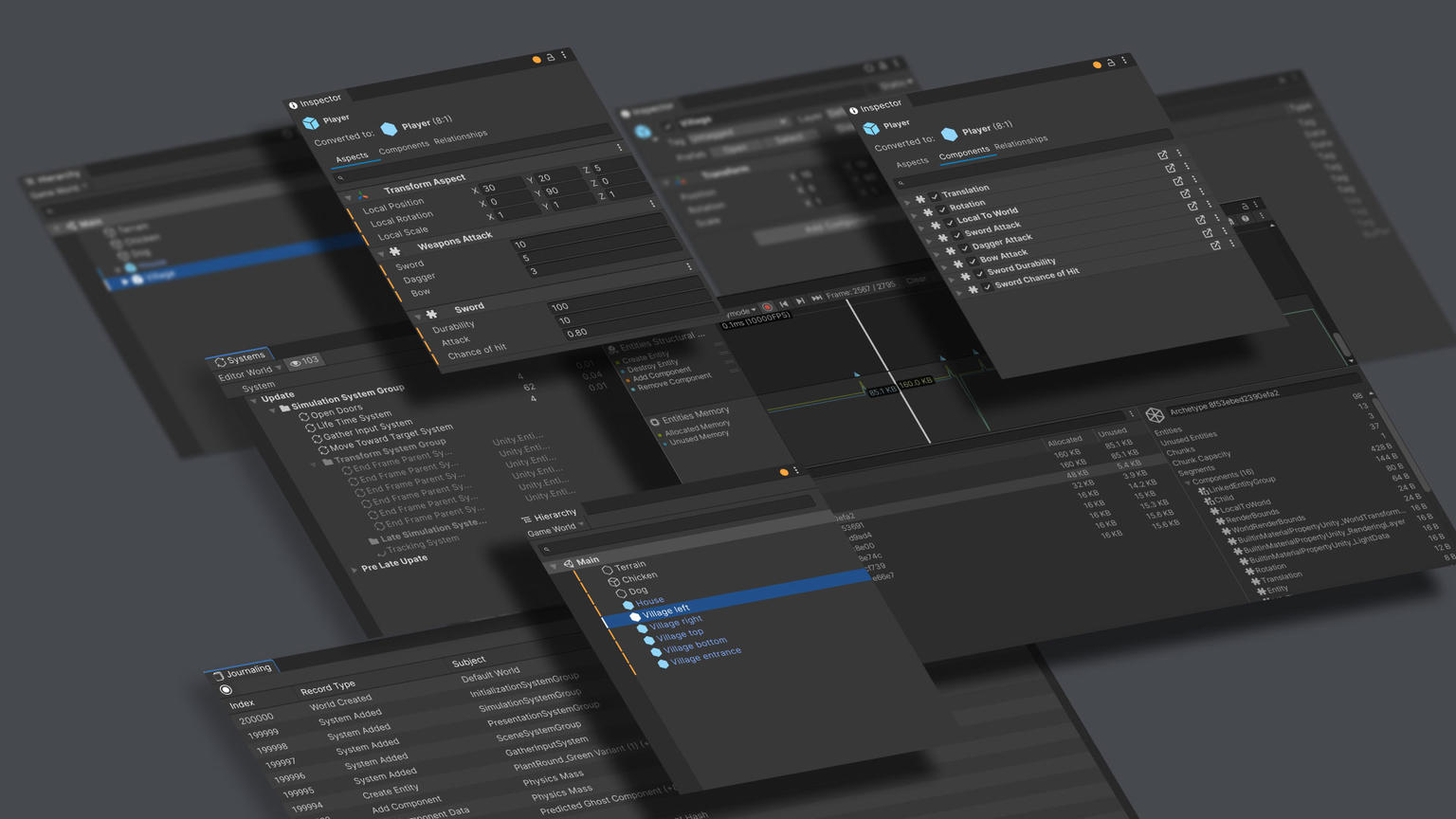
Unleash Creativity and Engagement with Dots Unity
Unity Technologies unveiled the initial details of its newly developed DOTS system through a blog post, sharing the exciting technological advancements with the global community. Merely a month later, the company showcased the complete capabilities of the system at the renowned Game Developers Conference (GDC) in March. It’s worth noting that Unity Technologies is the prominent entity behind the Unity game engine, widely acclaimed and extensively utilized by game developers worldwide.
So, what exactly is DOTS?
DOTS is an abbreviation for “Data-Oriented Technological Stack,” which signifies a game development system that introduces significant modifications to the previous frameworks employed in the Unity game engine. Given the vast number of game developers who rely on the Unity engine, it’s natural that many are now eagerly anticipating the impact of these developments on their own development processes. Consequently, there is substantial curiosity surrounding this topic, and in the following paragraphs, we will delve into the intricacies of DOTS and explore its implications for game development.
- DOTS incorporates several key features that aim to enhance convenience and efficiency for developers, while also harnessing the full potential of modern multi-core processors. These enhancements are made possible by introducing unique characteristics and functionalities.
- One of the most notable changes in DOTS is the shift from object-oriented programming (OOP) to data-oriented programming (DOP). While OOP revolves around objects with their own classes, functions, and data properties, DOP takes a different approach by focusing on the data that comprises those objects.
- This departure from traditional OOP enables DOP to efficiently execute actions on groups of objects by organizing their data into homogeneous clusters. By doing so, DOP maximizes the utilization of multi-core processors and improves cache implementation. While OOP is widely favored for its cleaner and more straightforward code structure, it often poses challenges in parallelization, potentially leading to significant performance degradation. DOP’s data-centric approach resolves these issues and facilitates more efficient and sequential application of changes.
Nonetheless it is essential to acknowledge certain potential challenges associated with multithreading practices – namely race conditions wherein two or more threads endeavor simultaneous modifications upon shared data repositories. Fortunately enough. This updated iteration of the C# Job System boasts fortified safeguards that effectively mitigate risks associated with race conditions and other common obstacles commonly faced when dealing with multithreaded game systems or similar projects. As part of Unitys ongoing endeavor to reimagine classical Unity systems via DOTS frameworks. We introduce the highly versatile Unity Entity Component System (ECS). This particular system adeptly organizes constituent elements within games or programs into three primary categories: entities, components, and systems.
Entities fundamentally serve as unique identifiers that efficiently group together pertinent data relating to distinct entities present within respective in game contexts. On the other hand components comprehensively encompass all vital datasets utilized by the given game or program and are systematically cataloged and indexed according to their corresponding entities. Lastly systems function as pivotal engines responsible for propagating logical transformations of data from one state to another – thereby driving progression and enhancing overall experiences across the gaming realm or any given programmatic environment.

Next step
After transitioning to data-oriented programming, the ECS (Entity Component System) data layout, often confused with the ECT (Enterprise content management) tech stack, has undergone significant changes. These updates bring forth several positive improvements, including memory optimization, enhanced load times, and improved data serialization within the ECS system’s technological process. In the larger context, these updates make it easier to reuse code and facilitate collaboration among multiple developers.
The design process is streamlined through the ECS platform, which works seamlessly with the C# Job System and Burst Compiler to fully harness the capabilities of multi-core processors. It’s worth clarifying that some users unfamiliar with the ECS term mistakenly associate it with Unity ECM, but the two concepts are distinct. The company’s website offers comprehensive ECS documentation, including Unity3D ECS documentation, as well as resources on entity programming and the entity system framework.
Unity Burst Compiler
Now let’s dive into the Unity Burst Compiler. Similar to other code compilers. The Unity Burst Compiler converts a developers’ source code into executable machine code. This machine code is then used by the computer processor to carry out tasks. What makes the Unity Burst Compiler special is its ability to convert IL/.NET code into native code using LLVM technology. By integrating C# jobs into the native job system the updated Burst Compiler generates highly optimized machine code. This advancement is a great benefit for developers as it reduces the need for manual code writing or generic tech compiler data systems.
- Additionally it optimizes the performance across various platforms where the code is compiled for. It’s important to mention that the Burst Compiler seamlessly works with a data object oriented repository system, a standard ECS database, and other technological system components utilized in DOTS. If you have an idea or concept that you want to materialize using Unity engine you are not alone in this endeavor. Each year. Numerous games and programs embark on development journeys; however. Not all of them reach completion.
- Most Unity projects require a dedicated team of skilled professionals along with significant time and resources. As the DOTS system and its related data oriented architecture are currently in preview mode. You have the freedom to develop your project using the classic Unity build which may necessitate assistance from a development company.
- As you embark on a Unity project, it’s essential to understand the scope and scale of the task at hand. Transforming an idea or concept into a fully-fledged game or program requires careful planning, skilled implementation, and diligent iteration. With the immense popularity of the Unity engine and the continuous advancements introduced by Unity Technologies, it’s crucial to stay informed about the latest developments, such as the DOTS system and its associated technologies.
The DOTS system represents a significant evolution in game development, offering developers a powerful toolkit to create optimized and efficient experiences. While the system is currently in preview mode, it has already garnered immense interest and anticipation from the Unity community.
One of the advantages of DOTS is its data-oriented approach, which emphasizes organizing and manipulating data efficiently. By focusing on data instead of traditional object-oriented programming, developers can leverage the full potential of modern multi-core processors. This shift enables better parallelization, improved performance, and a more streamlined utilization of system resources.
Fundamental part
Working in tandem with the data-oriented approach is the Unity Entity Component System (ECS), a fundamental part of the DOTS ecosystem. ECS provides a structured framework for organizing game elements into entities, components, and systems. Entities act as individual “things” within the game or program, components represent the data associated with those entities, and systems drive the logic for transforming data and governing the overall behavior of the game or program. ECS promotes modularity, reusability, and scalability, allowing developers to create complex and intricate systems with ease.
- To fully leverage the capabilities of multi-core processors, DOTS integrates seamlessly with the C# Job System and the Burst Compiler. The C# Job System enables efficient parallel execution of tasks by distributing them across available processor cores.
- This enables developers to take advantage of multi-threading, significantly enhancing performance. The Burst Compiler, on the other hand, optimizes code execution by transforming IL/.NET code into native machine code, utilizing LLVM technology. The result is highly optimized machine code that maximizes the capabilities of the underlying hardware.
- It’s worth noting that while the DOTS system and its related technologies offer immense potential, they are still in the preview phase. Unity Technologies actively gathers feedback and refines the system based on user experiences and requirements. This continuous development and improvement process ensure that when DOTS reaches its stable release, it will be a robust and reliable tool for game developers.
As you navigate the intricacies of Unity development, it’s essential to access the wealth of resources and documentation available. Unity Technologies provides comprehensive documentation on the DOTS system, ECS, and related technologies on their website. The documentation covers topics ranging from the basics of entity programming to advanced system framework implementation. Exploring these resources will enhance your understanding and proficiency in using DOTS effectively.
Overall
Furthermore, engaging with the vibrant Unity community can be immensely beneficial. Online forums, social media groups, and Unity-specific websites provide platforms for developers to share insights, ask questions, and learn from one another’s experiences. Collaborating and exchanging ideas with fellow developers can unlock new perspectives, solutions, and creative approaches to game development.
In conclusion, the DOTS system represents a paradigm shift in game development within the Unity ecosystem. Its data-oriented approach, integration with the ECS, C# Job System, and Burst Compiler offer developers powerful tools to create optimized and efficient experiences. While the system is still in the preview phase, its potential impact on game development is significant. By staying informed, exploring resources, and engaging with the Unity community, developers can harness the full capabilities of the DOTS system and create compelling and immersive games and programs.